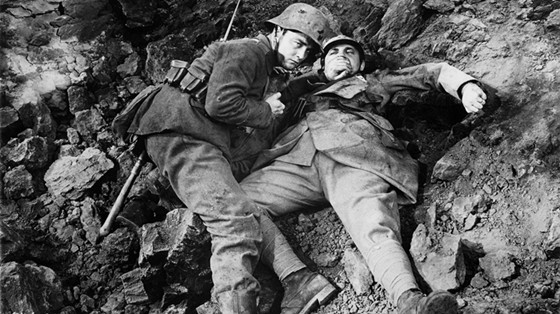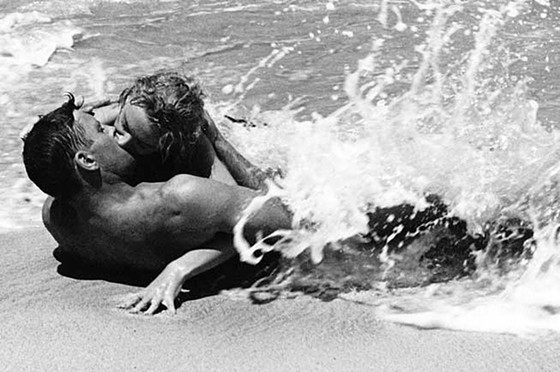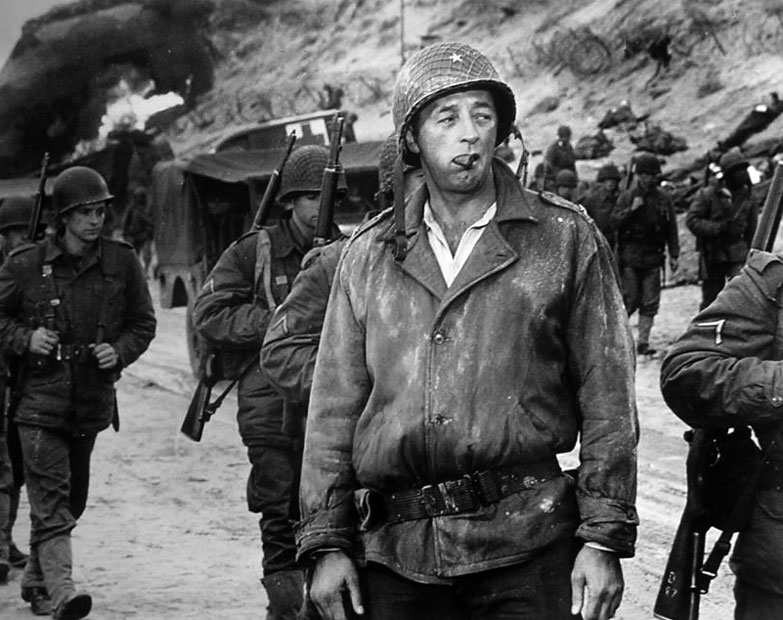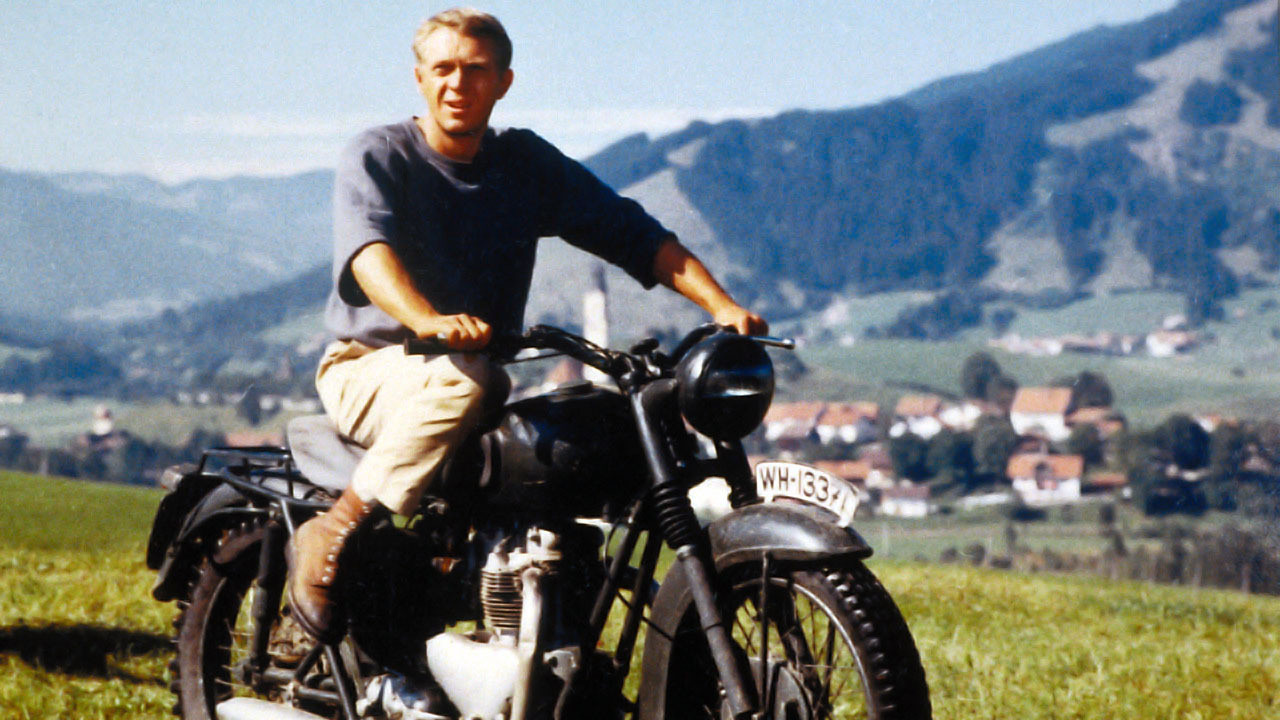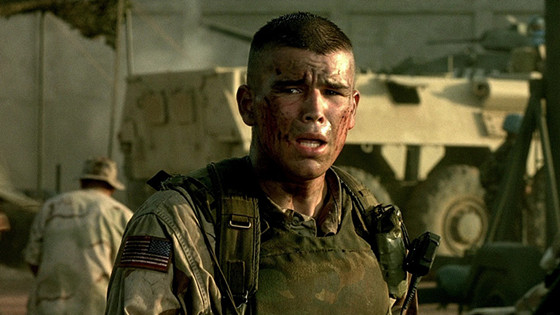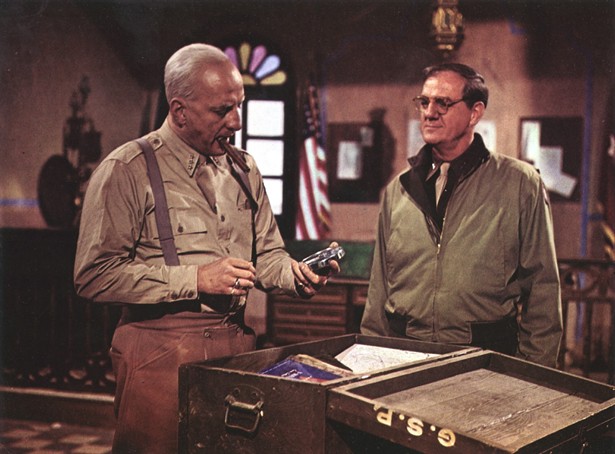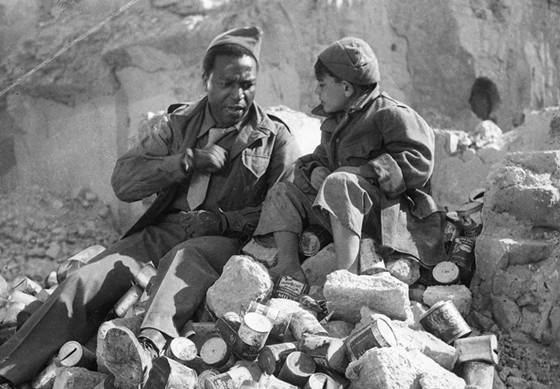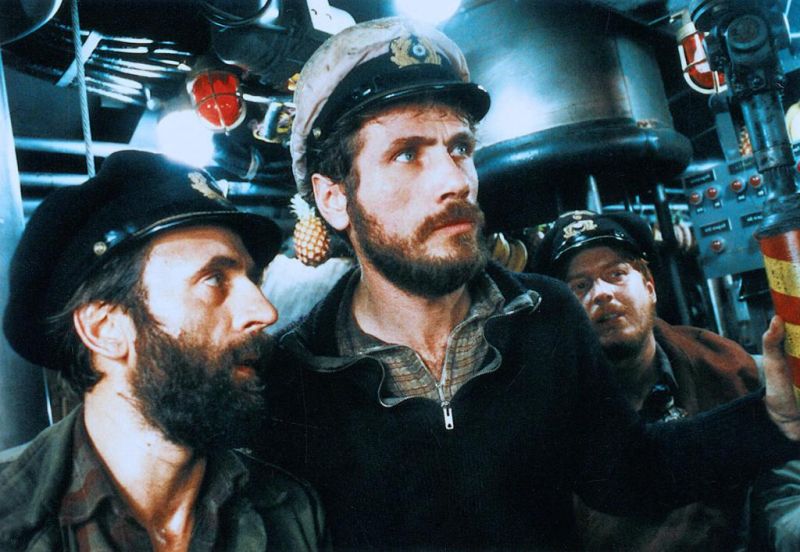23. All Quiet on the Western Front (Lewis Milestone, 1930)
Based on the 1929 novel of the same name by Erich Maria Remarque, All Quiet on the Western Front is one of the most celebrated anti-war movies ever made.
The film follows a group of young friends as they enlist in the army, go to basic training and are then sent to the Western Front in World War I. From the moment they arrive at the front line, their initial enthusiasm to save the fatherland takes a severe beating as the harsh realities of war immediately sink in.
All Quiet on the Western Front is a remarkable film in many ways. It’s an American production but the story is told from the perspective of young German soldiers. And whilst some of the dialogue and acting might have dated a little nowadays, the film was an enormous step forward in its realistic depiction of the horrors of war at the time.
There are many stand-out sequences like the school teacher inspiring the boys to go to war, the sweeping crane shots of the trench-filled battlefield, the montage which follows what happens to the boots of one of the soldiers after he loses his legs or the scene in which the lead character reaches out from his trench to catch a butterfly. The film won Academy Awards for Best Picture and Best Director and remains one of the greatest anti-war statements to have ever graced the screen.
22. From Here to Eternity (Fred Zinneman, 1953)
Based on the best-selling novel of the same name by James Jones, From Here to Eternity was a highly anticipated film when it came out in 1953. Not only had the book it was based on been a great success and considered rather explicit at the time, it was also directed by Fred Zinneman, who had released the highly successful High Noon the year previously, and featured an all-star cast of some of Hollywood’s most popular stars whilst also including Frank Sinatra, whose acting career had been seriously waning.
The film takes place at the Schofield Army Barracks in Honolulu in the days before the fateful attack on Pearl Harbor. The movie follows a few people stationed there, primarily focusing on three soldiers: Sergeant Milt Warden (Burt Lancaster), who starts a relationship with the wife (Deborah Kerr) of his commanding officer, Private Robert Prewitt (Montgomery Clift), a bugler and former middleweight boxer who has recently been transferred to the barracks and his friend Maggio (Frank Sinatra), who is being targeted by the vicious Sergeant “Fatso” Judson (Ernest Borgnine) after having had an argument with him in a local brothel.
Essentially a melodrama set during war time, all these characters’ dramatic storylines intertwine until the Japanese attack on Pearl Harbour renders them meaningless.
Featuring outstanding performances from the entire cast with special mention for Clift, who gives the performance of a lifetime, Borgnine, who turned his character into a very memorable and despicable villain and Frank Sinatra, who managed to become an actor to suddenly be taken seriously after his stunning portrayal of the tragic Maggio, From Here to Eternity turned out to be a huge success.
The film managed to be nominated for thirteen Oscars, taking home eight of them including Best Picture, Best Director and Best Adapted Screenplay. The film is however probably best remembered for its at the time very risqué scene on the beach of Burt Lancaster getting it on with Deborah Kerr, an overtly sexual and married woman to boot; something which was simply not portrayed and therefore ground breaking in Hollywood movies of the time.
21. The Longest Day (Ken Annakin, Andrew Marton, Bernhard Wicki & Gerd Oswald, 1962)
Before there was Saving Private Ryan, there was The Longest Day, an epic depiction of D-Day featuring a huge all-star ensemble cast and adapted from the history book of the same name by Cornelius Ryan. The film also featured many performances by military consultants who re-enacted their roles from the actual invasion as well as serving as advisors for the film’s production.
Shot in an almost docudrama style, the film starts of by depicting events immediately preceding D-Day on both the Allied and German sides before following the invasion itself and some of the most significant events surrounding it, which include the Allies landing on the beach, paratroopers parachuting into Sainte-Mère-Église, a grand overhead long take of the troops fighting in the streets of Ouistreham and the assault on Pointe du Hoc, the most important strategic point for the defence of the beaches by German forces. The movie concludes with the Allied Forces re-grouping after the successful taking of the coast and the start of their campaign inland.
A huge international undertaking in which all actors spoke in their native language, being subtitled when not speaking English, The Longest Day is still one of the grandest scale war movies ever made. The over-abundance of star-power means that some great actors only appear in near cameo appearances and the dialogue and screenplay might be somewhat stilted at times but the scale of the film and some of the striking cinematography still make this a truly astounding production.
Amongst the cast members are John Wayne, Henry Fonda, Robert Mitchum, Rod Steiger, Sean Connery, Richard Burton, Robert Ryan, Robert Wagner, Jean-Louis Barrault, Jean Servais, Arletty, Gert Fröbe, Curt Jürgens and many, many more. The movie ended up being nominated for five Academy Awards, ultimately winning two for Cinematography and Special Effects.
20. The Great Escape (John Sturges, 1963)
Based on the book of the same name by Paul Brickhill, which was a non-fiction work about a mass escape from a German prisoner of war camp in Poland during WWII, The Great Escape was a great commercial success and boosted the careers of many of its all-star cast.
As many of their prisoners keep escaping, the Germans have built a special high-security POW camp in which they round up all their most troublesome prisoners from all over Europe, who have managed to escape multiple times from different camps before. But putting these men together leads to only one thing: the moment they get there they start making plans on how to bust out of this seemingly inescapable structure. It is decided that three separate tunnels will be dug and the men go to work, lead by British Bartlett (Richard Attenborough).
Amongst the men are American rebel Hilts (Steve McQueen), Polish tunnel digger Danny (Charles Bronson), American scrounger Hendley (James Garner), American “manufacturer” Sedgwick (James Coburn) and British forger Blythe (Donald Pleasence).
The men overcome many obstacles building the three tunnels but when one of them is discovered by the Nazis, they decide to abandon another and focus on the sole remaining one. The last tunnel is ultimately finished but proves to be too short. Nonetheless 26 men manage to escape the camp but they now will still have to make it through German occupied territory in order to make it to freedom.
Clocking in at nearly three hours and featuring an all-star cast, The Great Escape is a truly epic adventure with a fantastic score by Elmer Bernstein, which adds to the film tremendously.
The film was very popular and did extremely well at the box-office but did not receive much critical praise at the time of its release as it was generally viewed as a well made action film and nothing more than light escapist entertainment. Over the years however, its critical stature has grown significantly and it’s now rightfully seen as a genuine cinema classic. And who doesn’t know that whistled tune?
19. Black Hawk Down (Ridley Scott, 2001)
In all honesty I wasn’t sure whether to include Black Hawk Down on this list as the movie might be better described as a two hour plus continuous battle-scene than what I would consider a proper war movie. Ultimately though, that’s exactly why I did decide to include it, as not many features will rival the constant edge-of-your-seat relentless action mayhem, which constitutes this film by director Ridley Scott, who once again proves that visuals, and not so much the telling of a story, are where his talents lie.
The film is an adaptation of the book of the same name by Mark Bowden, in turn based on his own articles for The Philadelphia Inquirer, describing the events of the Battle of Mogadishu.
When on October 3rd, 1993, an operation to kidnap two top advisors of a Somalian crime lord by an elite U.S. Army Rangers team with links to the United Nations goes horribly wrong, two Black Hawk helicopters are shot down, leaving the survivors stranded in hostile territory. From there on in, the movie is one long battle sequence as the men try to hold their ground and others are sent in to retrieve them amongst full-blown chaos and constant enemy fire.
Black Hawk Down is amongst the minority of titles on this list which can not be described as an anti-war film. Instead it’s a slick and visually impressive action film which moves at a breakneck pace and one of those films which is more like a heroic army recruitment video than a film trying to provide insight into the horrors of war. Whilst that might sound negative, there is no denying that what this film sets out to to, it does exceedingly well.
Scott manages to visualize clearly what is going on for the viewer whilst they are being immersed into pure chaos and uses an array of visual techniques to keep things fresh and exciting. From the moment the mission starts, the action is virtually non-stop until the credits start rolling and it’s kinetic nail-biting stuff all along the way. Featuring an impressive cast including Josh Hartnett, Tom Sizemore, Ewan McGregor, Eric Bana, William Fichtner, Sam Shepard, Ewan Bremner and a young Tom Hardy, Black Hawk Down was amongst the year’s best.
18. Patton (Franklin J. Schaffner, 1970)
Based on the biography Patton: Ordeal and Triumph by Ladislas Farago and Omar Bradley’s memoir A Soldier’s Story and adapted for the screen by Francis Ford Coppola and Edmund H. North, Patton is a biographical war film about General George S. Patton featuring a true tour de force performance by George C. Scott.
The film opens with a monologue from Patton to his troops, based on a speech the real-life General made in 1944, as he stands in front of a giant American flag. From there the movie goes directly into the African campaign in 1943 where Patton assumes command of the demoralised forces who have been fighting the German forces under command of Field Marshal Rommel. After he leads his troops to victory there, Patton is deployed to Sicily where he refuses to adhere to the plans of British Field Marshal Montgomery and pushes on forward to capture both Palermo and Messina.
But when he visits an army hospital and slaps and threatens to shoot a combat fatigued soldier for being a coward, the General is relieved of his command and stationed in England during D-Day. When he begs his former subordinate General Omar Bradley to be given the chance to command again, he is given the US 3rd Army, which he effectively leads through Europe. Ultimately however, he loses command again as he remains too outspoken about both American politics and his opinions on the other Allies.
Considered one of the best biopics ever made and featuring an opening monologue which has become truly iconic, Patton is a truly epic war film about a man who is seemingly bigger than life. The film was nominated for ten Academy Awards and took home seven of the statues, including Best Picture, Best Director and Best Actor for George C. Scott, who famously refused to accept the accolade, stating that he disliked the idea of acting competitions, making him the first actor ever to do so.
17. Paisan (Paisà) (Roberto Rossellini, 1946)
The second entry in Roberto Rossellini’s War/Neorealist Trilogy might at times be overshadowed by Rome, Open City but it is a masterpiece in its own right and I could not bear to not include it in this list as well. Another prime example of Italian neorealism and in contrast to Rome, Open City, which did not do that well in Italy at the time of its release due to the fact that the film might have been a bit too topical and grim, was a great success upon its release in its native country.
The film is divided in six episodes, all dealing with the Italian Campaign as Italy was slowly being freed from German occupation by the Allied forces. The first episode deals with an American soldier from a reconnaissance patrol who is assigned to guard a Sicilian woman as the rest of his group scout the area.
The second segment tells the story of a black MP whose shoes are stolen in Napels by an orphaned and impoverished boy. The third story deals with a drunken GI who returns to Rome six months after the liberation of the city to look for a girl he met there earlier on and fails to recognise the prostitute he hooks up with as the woman he is in fact looking for.
The fourth episode is set in Florence, of which only the Southern half has been liberated, as an American nurse and an Italian partisan try to find loved ones in the still occupied Northern half of the city.
The fifth segment consists of a three American chaplains, one a Catholic, one a Protestant, and one a Jew as they stay the night in a monastery ran by Franciscan monks, who initially assume that all their guests are Catholics. And the last story involves members of OSS fighting alongside Italian partisans behind enemy lines in the Po valley with a group of German soldiers, who refuse to surrender.
Just like Rome, Open City, Paisan brought together two of Italy’s greatest filmmakers as both movies were co-written and co-directed by Federico Fellini (amongst others), albeit in an uncredited capacity. Paisan was largely funded by American investors after Rome, Open City, had been a great success overseas and Rossellini decided to make the movie about the liberation of Italy by Allied forces and shooting most of the film in English as a result.
Non surprisingly the theme of communication problems due to language barriers is a major one in many of the film’s episodes. The film was met with unanimous critical praise and nominated for Best Original Screenplay at the Oscars and Best Film at the BAFTA Awards.
16. Das Boot (Wolfgang Petersen, 1981)
Based on the novel of the same name by Lothar-Günther Buchheim, Das Boot is an epic German war movie following the exploits of a U-Boat and its crew in World War II. The film exists in many different versions, which are best summarised by the following three: the original theatrical cut (150 minutes), the 1997 director’s cut (209 minutes) and a mini-series version, which runs for nearly six hours in total.
Das Boot is told from the perspective of Lieutenant Werner, a war-correspondent who has been assigned to report on the in and outs of a German U-Boat and her crew in 1941. Not very much concerned with the greater picture of the ongoing war, the film follows the boat’s Captain (Jürgen Prochnow) and his crew as they spend most of their time going about their chores and being bored in their claustrophobic leaky metal environment, hunting the Atlantic for enemy ships.
These long stretches of tedious routine and hunting for enemies are alternated with nail-biting battle scenes as the U-Boat sinks enemy vessels or is hunted by them.
Considered one of the best German movies ever made, the real star of Das Boot is cinematographer Jost Vacano, who manages to always keep the viewer intrigued by finding many ways to explore the limited space in the sub, even when the crew spends long hours doing nothing but routine jobs and hunting for enemies in a seemingly endless ocean.
The film perfectly captures the sense of paranoia of what it must be like to live in a cramped metal environment deep underneath the ocean’s surface. Das Boot was nominated for six Academy Awards, including Best Director and Best Cinematography, but ended up winning none. It did manage to take home a whole string of awards at various ceremonies in Germany and is rightfully considered as the best submarine movie ever made.
